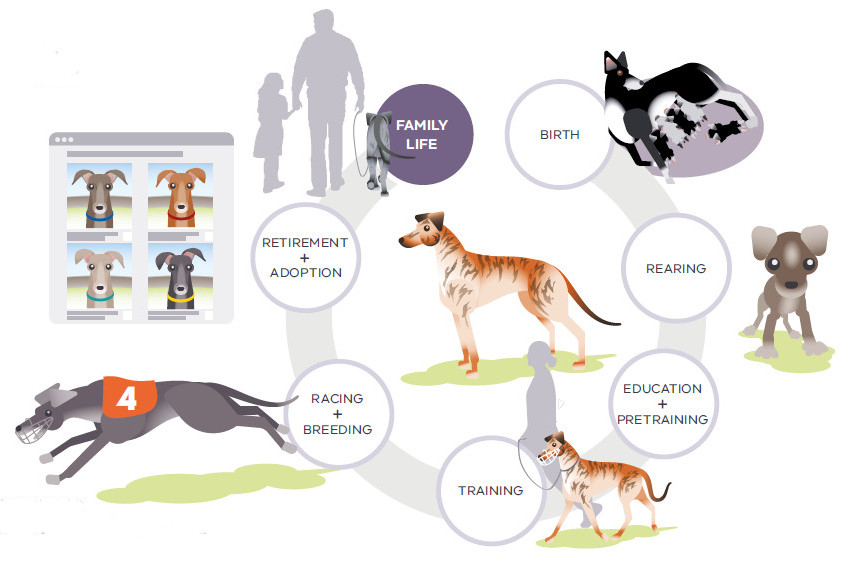A visual guide to the new Code of Practice for the Keeping of Racing Greyhounds
A visual guide to the new Code of Practice for the Keeping of Racing Greyhounds.
Greyhound husbandry
![]()
- Puppy vaccinations complete by 16 weeks.
- Annual health checks and vaccinations required for all greyhounds.
- Muzzles must not prevent panting or drinking or cause pain or distress.
- Emphasis on critical socialisation period.
- Greyhounds can be exercised, socialised and enriched according to the Code or alternate protocols in the approved Establishment Health Management Plan (EHMP).
- Greyhounds can be prepared for rehoming using the process outlined in the Code or alternate protocols in the approved EHMP.
- Stress intervention and possible management actions must be recorded in the approved EHMP.
Facilities
![]()
Fences, kennels and yards
- Fences must be constructed to prevent greyhounds from being injured or escaping.
- Minimum of two barriers between greyhounds and escape from the establishment.
- Barriers must be at least 1.2m high
- 3 to 9m² for single greyhound housing only. They need a minimum of four breaks daily.
- 10m² of housing required per each additional greyhound.
- Weatherproof area is required for all outdoor pens or yards.
- 15m² whelping area can include adjoining exercise or day yards.
Records
![]()
- Greyhound record to be a complete health history for each greyhound.
- Individual greyhound records required from birth.
- Greyhounds being sold, given away or moved from an establishment must be accompanied by their up-to-date greyhound record.
- Greyhound record to follow a greyhound each time it moves between establishments or Persons in Charge.
Staffing and staff ratio
![]()
- Person in Charge is accountable for greyhound welfare and establishment management.
- Establishments must have a sufficient number of suitably qualified or experienced staff to care for all greyhounds.
- 1:50 ratio for greyhounds over 16 weeks of age and 1:25 thereafter.
- 1:20 ratio for greyhounds under 16 weeks of age. This acknowledges the critical socialisation period for puppies (3 to 16 weeks).
- For 50 or less greyhounds, overnight monitoring (in person or remote) only required to care for whelping, sick or injured greyhounds.
- Overnight monitoring (in person or remote) only required for all establishments with 51 or more greyhounds.
- Mandatory training for all new industry participants, training for existing participants as required.
Establishment and Health Management Plan (EHMP)
![]()
- Flexibility for participants to develop their own protocols and procedures.
- Mandatory for all Persons in Charge keeping racing greyhounds.
- If the Code's minimum requirements are not adopted, alternative protocols for exercise, socialisation, enrichment and rehoming requirements can be outlined in the EHMP.
- Does not include training protocols.
- Approved by a veterinary practitioner initially and then every three years after.
- Submitted to Greyhound Racing Victoria (GRV).
- Reviewed annually by Person in Charge.
Timeline
- February 2015 — Four Corners live baiting report
- April 2016 — Bittar Report
- 2016 to 2018 — Review existing code
- 14 June 2017 — Draft code released
- April 2018 — Code released
- 2018 to 2019 — Implementation planning
- 1 January 2019 — Muzzles off for non-racing greyhounds
- 1 January 2020 — Code commences
- 2020 onward — Implementation of the code
Life stages of a racing greyhound
{image: infographic-life-stages-of-a-racing-greyound.jpg ALT: An infographic that shows the life stages of a racing greyhound from Birth, rearing, education and pre-training, training, racing and breeding to retirement and adoption, and family life}
This page is also available as a PDF. View New Code of Practice for the keeping of racing greyhounds infographic.
Page last updated: 01 Dec 2025

